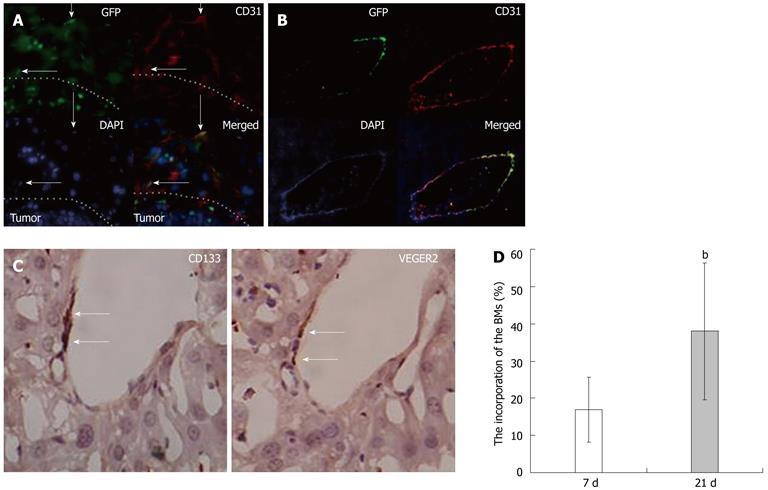Copyright
©2012 Baishideng Publishing Group Co.
World J Gastroenterol. Sep 21, 2012; 18(35): 4925-4933
Published online Sep 21, 2012. doi: 10.3748/wjg.v18.i35.4925
Published online Sep 21, 2012. doi: 10.3748/wjg.v18.i35.4925
Figure 3 Bone-marrow-derived endothelial progenitor cells were found to contribute to vessel formation in hepatocellular carcinoma tissues.
A: Bone marrow derived endothelial progenitor cells (EPCs) incorporated into peritumoral vessels; B: Distribution of CD133 and VEGFR2 antigens in hepatocellular carcinoma (HCC) liver vessels (Arrows: Double-positive cells, CD133+ VEGFR2+ cells incorporating into microvessels in the liver. Magnification, 400); C: Bone-marrow (BM)-derived EPCs incorporated into hepatic veins [Red: Mature vascular endothelial cells (VECs) are marked by CD31; Green: BM derived cells expressing green fluorescent protein (GFP); Blue: Nuclei stained by DAPI; Arrows: VECs co-expressing GFP and CD31, frozen, HCC, 2 μm, magnification 400]; D: The incorporation rate of the EPCs in HCC blood vessels at 7 d vs that observed at 21 d. bP < 0.01 vs that observed at 21 d, n = 15. DAPI: 4',6'-diamidino-2-phenylindole hydrochloride.
- Citation: Sun XT, Yuan XW, Zhu HT, Deng ZM, Yu DC, Zhou X, Ding YT. Endothelial precursor cells promote angiogenesis in hepatocellular carcinoma. World J Gastroenterol 2012; 18(35): 4925-4933
- URL: https://www.wjgnet.com/1007-9327/full/v18/i35/4925.htm
- DOI: https://dx.doi.org/10.3748/wjg.v18.i35.4925









